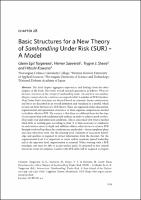Chapter 28 Basic Structures for a New Theory of Samhandling Under Risk (SUR)
A Model
Author(s)
Torgersen, Glenn-Egil
Saeverot, Herner
Steiro, Trygve J.
Kawano, Hitoshi
Language
EnglishAbstract
"This final chapter aggregates experiences and findings from the other
chapters of the book. The book’s overall research question is as follows: What are
the basic structures of the concept of samhandling under risk and how can samhandling
be created when the conditions are unpredictable? A number of SUR (Samhandling
Under Risk) structures are derived based on semantic theory construction,
and these are described in an overall definition and visualized in a model, which
in turn can form the basis of a SUR theory. These are organized under educational,
organizational and operational structures, as three superior competencies needed
to facilitate effective SUR. The essence is that there is a different basis for this type
of assessment than with traditional risk analysis, in order to achieve good samhandling
under risk and unforeseen conditions. This is concerned with what is needed
when little or nothing goes according to plan. It is then necessary to emphasize
on such matters more in depth and addition address other factors to achieve SUR
through samhandling where the conditions are predictable - where completed plans
and clear objectives work. For the learning level, valuation of inaccurate knowledge
and qualities is required to extract information from the disorder. For the
organizational level, it is important to create and/or maintain shared leadership
and at the operative level, improvisation is essential. When working with a SUR
paradigm, one must be able to accept unclear goals, be prepared to lose control
and create room for surprises. Leaders with SUR skills will be required to prepare organizations for this. Training and SUR should be incorporated into strategic
plans, management training and leadership development. An expansion of established
pedagogical models is also needed to achieve this aim. Invisible learning is
one approach. Samhandling does not simply happen in a vacuum, and the chapter
encourages further SUR research in a global perspective, where different languages
and cultures can contribute to enhanced understanding of SUR issues. As a starting
point for such an approach, we explore how the term is expressed in the Japanese
language. A more global approach to SUR structures can contribute to a deeper
understanding of what is needed, to avoid unwanted misunderstandings and crises,
learn from each other and solve complex and unforeseen situations through
samhandling."
Keywords
Samhandling; interaction; SUR; semantic model; training; strategy; global understanding; organizational learning; unforeseenDOI
10.23865/noasp.36.ch28OCN
1076653478Publisher website
https://www.cappelendamm.no/Publication date and place
Oslo, 2018Classification
Society and Social Sciences
Warfare and defence
Military and defence strategy


 Download
Download